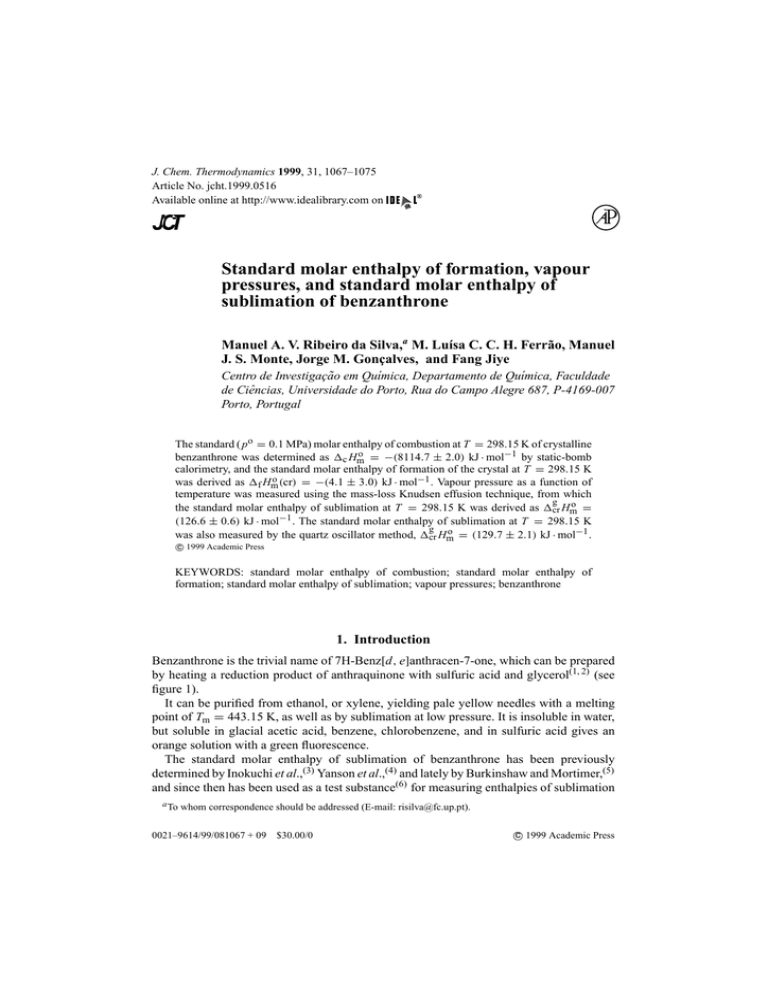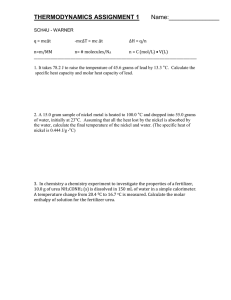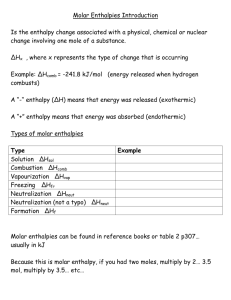Standard molar enthalpy of formation, vapour sublimation of benzanthrone
advertisement

J. Chem. Thermodynamics 1999, 31, 1067–1075
Article No. jcht.1999.0516
Available online at http://www.idealibrary.com on
Standard molar enthalpy of formation, vapour
pressures, and standard molar enthalpy of
sublimation of benzanthrone
Manuel A. V. Ribeiro da Silva,a M. Luı́sa C. C. H. Ferrão, Manuel
J. S. Monte, Jorge M. Gonçalves, and Fang Jiye
Centro de Investigação em Quı́mica, Departamento de Quı́mica, Faculdade
de Ciências, Universidade do Porto, Rua do Campo Alegre 687, P-4169-007
Porto, Portugal
The standard ( p o = 0.1 MPa) molar enthalpy of combustion at T = 298.15 K of crystalline
o = −(8114.7 ± 2.0) kJ · mol−1 by static-bomb
benzanthrone was determined as 1c Hm
calorimetry, and the standard molar enthalpy of formation of the crystal at T = 298.15 K
o (cr) = −(4.1 ± 3.0) kJ · mol−1 . Vapour pressure as a function of
was derived as 1f Hm
temperature was measured using the mass-loss Knudsen effusion technique, from which
g o
the standard molar enthalpy of sublimation at T = 298.15 K was derived as 1cr Hm
=
−1
(126.6 ± 0.6) kJ · mol . The standard molar enthalpy of sublimation at T = 298.15 K
g o
was also measured by the quartz oscillator method, 1cr Hm
= (129.7 ± 2.1) kJ · mol−1 .
c 1999 Academic Press
°
KEYWORDS: standard molar enthalpy of combustion; standard molar enthalpy of
formation; standard molar enthalpy of sublimation; vapour pressures; benzanthrone
1. Introduction
Benzanthrone is the trivial name of 7H-Benz[d, e]anthracen-7-one, which can be prepared
by heating a reduction product of anthraquinone with sulfuric acid and glycerol(1, 2) (see
figure 1).
It can be purified from ethanol, or xylene, yielding pale yellow needles with a melting
point of Tm = 443.15 K, as well as by sublimation at low pressure. It is insoluble in water,
but soluble in glacial acetic acid, benzene, chlorobenzene, and in sulfuric acid gives an
orange solution with a green fluorescence.
The standard molar enthalpy of sublimation of benzanthrone has been previously
determined by Inokuchi et al.,(3) Yanson et al.,(4) and lately by Burkinshaw and Mortimer,(5)
and since then has been used as a test substance(6) for measuring enthalpies of sublimation
a To whom correspondence should be addressed (E-mail: risilva@fc.up.pt).
0021–9614/99/081067 + 09
$30.00/0
c 1999 Academic Press
°
1068
M. A. V. Ribeiro da Silva et al.
O
FIGURE 1. Structure of benzanthrone.
of organic solids of low volatility, by means of the differential Knudsen effusion method in
conjunction with a quartz oscillator as a highly sensitive detector.
Despite its application as a test substance, the thermodynamic properties of this compound
have not been well defined so far. This paper reports the measurements of the standard
molar enthalpy of combustion of the crystalline solid, the vapour pressure as a function of
temperature, and the standard molar enthalpy of sublimation determined by the mass-loss
Knudsen effusion method and by a quartz oscillator method.
2. Experimental
Benzanthrone (Aldrich Chemical Co.) was purified(1) by repeated crystallization from
tetrachloroethane followed by repeated sublimation at low pressure. The purification process
was repeated until the combustion results were consistent and the carbon dioxide recovery
ratios were satisfactory. The purity of the compound was checked by elemental analyses;
the mass fractions w of C, H, and O were: C17 H10 O, obtained: 102 · w(C) = 88.60,
102 · w(H) = 4.40, 102 · w(O) = 6.92; expected: 102 · w(C) = 88.67, 102 · w(H) = 4.38,
102 · w(O) = 6.95.
The energy of combustion of benzanthrone was measured in a static bomb calorimeter;
the calorimeter, subsidiary apparatus, and technique have been described previously.(7, 8)
The energy equivalent of the calorimeter was determined from the combustion of benzoic
acid (Bureau of Analysed Samples, Thermochemical Standard CRM-190p) having a massic
energy of combustion, under standard bomb conditions, of −(26431.8 ± 3.7) J · g−1 . The
calibration results were corrected to give the energy equivalent ε(calor) corresponding
to the average mass of water added to the calorimeter, 3119.6 g. From eight calibration
experiments, ε(calor) = (16017.0 ± 1.3) J · K−1 , where the uncertainty quoted is the
standard deviation of the mean.
The samples of benzanthrone, in pellet form, were ignited at T = 298.15 K in oxygen
at the pressure 3.04 MPa with 1.00 cm3 of water added to the bomb. For the cotton-thread
fuse, empirical formula CH1.686 O0.843 , 1c u o = −16250 J · g−1 ;(9) this value has been
experimentally confirmed in our laboratory. Corrections for nitric acid formation were
g
o and 1 H o for benzanthrone
1f Hm
cr m
1069
based on −59.7 kJ · mol−1 for the molar energy of formation of 0.1 mol · dm−3 HNO3 (aq)
from N2 (g), O2 (g), and H2 O(l).(10)
The amount of substance used in each experiment was determined from the total mass
of carbon dioxide produced after allowance for that from the cotton-thread fuse. The
average ratios of the mass of carbon dioxide produced by benzanthrone in the combustion
experiments to that calculated from the mass of sample used was (0.9996 ± 0.0001). For
benzanthrone, (∂u/∂ p)T at T = 298.15 K was assumed to be −0.1 J · g−1 · MPa−1 , a typical
value for most organic solids. For each experiment, the value of 1c u o was calculated by
using the procedure given by Hubbard et al.(9)
The vapour pressure of benzanthrone as a function of temperature were measured using a
mass-loss Knudsen effusion apparatus. The detailed description of the apparatus, procedure,
and technique, and results obtained with test substances (benzoic acid and ferrocene) have
been reported.(11) This apparatus enables the simultaneous operation of three Knudsen cells,
with three different holes.
In each effusion experiment, the mass loss of the crystalline samples 1m was measured by
weighing the cells with the samples within ± 0.01 mg before and after a convenient effusion
time period t in a system evacuated to near p = 1 · 10−4 Pa. The cells were immersed in a
thermostatically controlled oil-bath. In each effusion experiment, at the temperature T , the
vapour pressure p was calculated by using the Knudsen equation:(12)
p = (1m/A0 w0 t)(2π RT /M)1/2 ,
(1)
in which M is the molar mass of the effusing vapour, R is the gas constant, A0 is the area of
the effusion hole, and w0 the Clausing factor w0 = {1 + (3l/8r )}−1 , where l is the thickness
of the effusion hole and r is the radius. The thickness of the effusion holes l was 0.049 mm,
and their areas and Clausing factors were: hole 1, A0 = 0.596 mm2 , w0 = 0.959; hole 2,
A0 = 0.813 mm2 , w0 = 0.965; hole 3, A0 = 0.862 mm2 , w0 = 0.966.
To derive the standard molar enthalpy of sublimation at the mean temperature hT i of
g
the experimental temperature range 1cr Hmo (hT i), the integrated form of the Clausius–
Clapeyron equation:
ln( p/Pa) = a − b · (K/T ),
g
1cr Hmo (hT i)/R,
(2)
was used.
where b =
The standard molar enthalpy of sublimation of benzanthrone was also derived from
measurements using a Knudsen effusion method with a quartz microbalance, as described
by Burkinshaw and Mortimer.(5) The vapour effusing from the Knudsen cell was allowed
to condense onto a quartz crystal positioned above the effusion hole.
The measurements were made with an Edwards 306 vacuum-coating unit, fitted with a
film thickness monitor (Edwards FTM3) incorporating a quartz crystal oscillator (6 MHz),
but with some modifications from the apparatus described by Burkinshaw and Mortimer.(5)
The cylindrical Knudsen cell was made of steel (o.d. 13 mm, i.d. 6 mm, length 8 mm).
The lid with an effusion-hole diameter of 0.8 mm was screwed on to the cell. The
complete cell was then screwed into an electrically heated cylindrical steel block, and the
temperature was controlled within ± 0.1 K by a proportional integral derivative controller,
Eurotherm 815. Temperatures were measured by a Labfacility P100/0620 platinum-sensing
1070
M. A. V. Ribeiro da Silva et al.
detector screwed into the effusion cell. Frequency changes in the quartz-crystal oscillator
circuit were measured with a Philips Frequency Counter PM6685 connected to the FTM3
film-thickness monitor.
The change in frequency of a quartz crystal 1 f is directly proportional(13) to the mass of
the substance deposited on its surface m, assuming that the total frequency change is small
when compared with f . The relation between 1 f and m was derived for AT-cut quartz
crystals vibrating in thickness shear mode, and can be expressed as:
1 f = ( f 2 /Aρ N ) · m,
(3)
where f is the average resonance frequency, A and ρ are, respectively, the surface area and
the density of the quartz crystal, and N is the quartz crystal frequency constant, defined
by N = f · l, where l is the thickness of the quartz plate (for an AT-cut quartz crystal
N = 1.67 · 103 Hz · m).
During an effusion experiment, the change in the resonance frequency ν = 1 f /t is
proportional to the rate of sublimed mass 1m/t of the crystalline sample and to the vapour
pressure:
(4)
1m/t = p A0 w0 (M/2π RT )1/2 ,
where p is the vapour pressure, A0 is the hole area, and w0 is the Clausing factor. Then:
ν = 1 f /t = c1m/t = cp A0 w0 (M/2π RT )1/2 ,
(5)
or, rearranging:
p = νT 1/2 {(2π R/M)1/2 /(c A0 w0 )}.
The integrated form of the Clausius–Clapeyron equation:
(6)
g
ln(νT 1/2 ) = ln B − 1cr Hmo /RT,
(7)
was used to derive the standard molar enthalpy of sublimation at the mean temperature of
g
the experimental range 1cr Hmo (hT i).
The values of the standard molar enthalpy of sublimation at the mean temperature of the
experimental temperature range, obtained by both methods, were corrected to T = 298.15 K
using the relation:
g
g
g
1cr Hmo (T = 298.15 K) = 1cr Hmo (hT i) + 1cr C op,m (298.15 K − hT i),
(8)
g
where the value of the standard molar heat capacity of sublimation 1cr C op,m =
−50 J · K−1 · mol−1 was assumed in accordance with estimations made by other authors.(5)
The molar masses used for the elements were those recommended by IUPAC in 1995.(14)
3. Results
The results of the combustion experiments are given in table 1, where 1m(H2 O) is the
deviation of the mass of water added to the calorimeter from the average mass assigned to
ε(calor), 1U6 is the correction to the standard state, and the remaining quantities are as
described previously.(9) As samples were ignited at T = 298.15 K:
−1U (IPB) = {ε(calor) + 1m(H2 O) · c p (H2 O, l) + εf }1Tad + 1Uign .
(9)
g
o and 1 H o for benzanthrone
1f Hm
cr m
1071
TABLE 1. Combustion results for benzanthrone at T = 298.15 K
m(CO2 )/g
2.43725
2.33787
2.40459
2.09834
2.35184
2.37106
m 0 (cpd)/g
0.74857
0.71798
0.73856
0.64433
0.72242
0.72798
m 00 (fuse)/g
0.00310
0.00313
0.00302
0.00297
0.00284
0.00355
1Tad /K
1.64900
1.58180
1.62672
1.41950
1.59123
1.60440
ε(calor)/(J · K−1 )
16017.4
10017.4
16017.0
16017.0
16017.0
16017.4
15.72
15.67
15.71
15.51
15.67
15.69
εf /(J · K−1 )
1m(H2 O)/g
0.1
0.1
0.2
0.0
0.0
0.1
−1U (IBP)/J
26437.46
25359.95
29081.00
22756.96
25510.48
25722.68
−1U(HNO3 )/J
5.07
3.60
4.24
4.75
4.53
4.01
−1U (ign.)/J
1.19
1.19
1.09
1.18
1.19
0.84
1U6 /J
−m 00 1c u o (fuse)/J
−1c u o (cpd)/(J · g−1 )
18.17
17.33
17.89
15.36
17.45
17.61
50.34
50.83
49.04
48.23
46.12
57.65
35218.99
35221.30
35216.95
35212.73
35218.27
35225.43
From the combustion results listed in table 1, the mean value of the massic energy of
combustion and its standard deviation are h1c u o i = −(35219.0 ± 1.7) J · g−1 . For the
molar quantities at T = 298.15 K: 1c Umo = −(8109.7 ± 2.0) kJ · mol−1 and 1c Hmo =
−(8114.7±2.0) kJ · mol−1 . With 1f Hmo (H2 O, l) = −(285.830±0.040) kJ · mol−1 ,(15) and
1f Hmo (CO2 , g) = −(393.51 ± 0.13) kJ · mol−1 ,(15) then 1f Hmo (C17 H10 O, cr) = −(4.1 ±
3.0) kJ · mol−1 . In accordance with normal thermochemical practice, the uncertainties
assigned to the standard molar enthalpy of combustion and formation are twice the standard
deviation of the mean, and include the uncertainties in calibration and in the values of the
auxiliary quantities used.
The experimental results obtained from each cell, at different temperatures for the
equilibrium vapour pressures, together with the residuals of the Clausius–Clapeyron
equation for benzanthrone are presented in table 2. These results and the global ones
obtained with the three cells used are fitted with equation (2) by using a least-squares
computer program. The plot of ln p = f (1/T ) for the individual effusion holes used for
benzanthrone is presented in figure 2.
The detailed parameters of the Clausius–Clapeyron equation, the mean temperature
of the experiments hT i, the standard molar enthalpy of sublimation at T = 298.15 K
g
1cr Hmo (T = 298.15 K), and the value for the global treatment of all ( p, T ) points obtained
are listed in table 3. The calculated enthalpies of sublimation obtained for each individual
hole are in agreement within experimental error. The mean of these values is also similar
to the value derived from the overall treatment of the global results.
Table 4 lists the ( p, T ) values calculated over the vapour pressure range p = 0.1 Pa to
p = 1.0 Pa from the overall treatment.
In table 5, the results of the effusion experiments with the quartz-crystal microbalance
for the determination of the standard molar enthalpy of sublimation of benzanthrone are
summarized. The plot of ln(νT 1/2 ) = f (1/T ) is shown in figure 3. From the slope
1072
M. A. V. Ribeiro da Silva et al.
–0.2
ln( p/Pa)
–0.6
–1.0
–1.4
–1.8
–2.2
2.43
2.46
2.49
2.52
1000 · K/T
FIGURE 2. Plot of ln p against 1/T for benzanthrone:
2.55
2.58
◦, hole 1; ¤, hole 2; 4, hole 3.
TABLE 2. Experimental Knudsen effusion results for vapour pressure
p, and residuals 1 ln( p/Pa) of the Clausius–Clapeyron equation for
benzanthrone
102 · 1 ln( p/Pa)
p/Pa
T /K
hole 1
hole 2
hole 3
389.20
0.1461
0.1410
0.1413
391.26
0.1806
393.15
0.2187
0.2101
394.94
0.2535
396.75
398.72
hole 1
hole 2
hole 3
−0.81
−2.02
−1.13
0.59
2.12
0.88
0.2109
1.75
0.01
1.29
0.2487
0.2465
−0.36
−0.02
0.08
0.2989
0.2957
0.2905
−0.79
0.35
−0.34
0.3610
0.3566
0.3485
−0.14
0.82
−0.29
401.12
0.4438
0.4369
0.4297
−1.45
−0.88
−1.22
403.10
0.5428
0.76
−0.38
0.31
405.10
0.6455
0.6327
0.6234
0.16
0.24
0.28
407.11
0.7712
0.7480
0.7382
0.12
−0.89
−0.59
409.04
0.9143
0.9003
0.8856
0.17
0.65
0.72
0.1792
0.5254
0.1756
0.5216
of the straight line obtained, 1cr Hmo (T = 381.9 K) = (125.5 ± 2.1) kJ · mol−1 , and
g
1cr Hmo (T = 298.15 K) = (129.7 ± 2.1) kJ · mol−1 .
g
g
o and 1 H o for benzanthrone
1f Hm
cr m
1073
TABLE 3. Knudsen effusion results for benzanthrone, where a and b are from the
g o
Clausius–Clapeyron equation, ln( p/Pa) = a − b · (K/T ), and b = 1cr Hm
(hT i)/R;
−1
−1
R = 8.314 J · K · mol
g
Hole number
a
b
1
35.69 ± 0.18
14636 ± 70
2
35.73 ± 0.22
14662 ± 86
3
35.51 ± 0.16
14579 ± 65
Global results
35.65 ± 0.19
14626 ± 75
g
hT i/K
o (hT i)
1cr Hm
kJ · mol−1
o (T = 298.15 K)
1cr Hm
kJ · mol−1
399.15
121.6 ± 0.6
126.6 ± 0.6
TABLE 4. The pressure p and temperature T
values from the vapour pressure equation for
benzanthrone
p/Pa
T /K
p/Pa
T /K
0.1
385.38
0.6
404.47
0.2
392.54
0.7
406.20
0.3
396.86
0.8
407.71
0.4
399.99
0.9
409.06
0.5
402.44
1.0
410.27
TABLE 5. Experimental values of the change of
frequency of the quartz oscillator ν at different
temperatures T by deposition of benzanthrone
T /K
ν/s−2
T /K
ν/s−2
372.8
0.11632
383.0
0.32972
373.7
0.12337
384.3
0.38199
374.7
0.13619
387.0
0.49429
375.3
0.15093
388.7
0.57582
376.1
0.16917
390.9
0.75315
377.6
0.19021
392.0
0.78205
379.0
0.22051
393.5
0.94176
380.5
0.25927
4. Discussion
For benzanthrone there are three previously reported values for the standard molar enthalpy
of sublimation: the value of 115.5 kJ · mol−1 at T = 398 K, determined by Inokuchi et
al.(3) using the mass-loss Knudsen effusion technique, yields the value of 120.5 kJ · mol−1 at
1074
M. A. V. Ribeiro da Silva et al.
3.5
ln{(νT 1/2 )/(s− 2 K1/2 )}
3.0
2.5
2.0
1.5
1.0
0.5
2.54
2.56
2.58
2.60
2.62 2.64
1000 · K/T
2.66
2.68
2.70
FIGURE 3. Plot of ln(νT 1/2 ) against 1/T for benzanthrone.
T = 298.15 K; the value of (114.2±0.8) kJ · mol−1 , determined by Yanson et al.(4) using the
quartz oscillator method, although the temperature to which it refers is not given; the value
of (119.7 ± 5.4) kJ · mol−1 at T = 370 K, determined by Burkinshaw and Mortimer(5)
using the quartz oscillator method, which yields the value of (125 ± 6) kJ · mol−1 for
T = 298.15 K.
The values obtained in this work by two different experimental techniques are in mutual
agreement taking into consideration the uncertainties ascribed to them, and also agree with
the value determined by Burkinshaw and Mortimer(5) using the quartz oscillator detector.
The Knudsen mass-loss effusion technique is a more accurate method, taking into account
that the experimental effusion conditions are closer to the theoretical ones which are the
basis of the Knudsen theory: this method allows the calculation of vapour pressures of the
crystalline solid at different temperatures, whereas the quartz oscillator method only yields
a quantity which is proportional to the vapour pressure.
Although the quartz oscillator method allows, with sufficient accuracy for most of the
necessities, the determination of standard molar enthalpies of sublimation for low vapour
pressure solids, and has the practical experimental advantages of requiring a much smaller
amount of sample, a less sophisticated experimental device, and of being a faster and easier
experimental method, it is not the preferred experimental method.
Taking into account all the above experimental limitations, the value of the standard
g
o and 1 H o for benzanthrone
1f Hm
cr m
1075
molar enthalpy of sublimation derived from the Knudsen mass-loss effusion technique is
preferred as a more accurate value for this property.
There are no previously determined values for the standard molar enthalpy of formation
of benzanthrone in the literature, and an insufficient number of thermochemical results for
compounds containing similar structures are available to permit estimation of an expected
value for this enthalpy of formation.
We gratefully acknowledge Fundação para a Ciência e Tecnologia, Lisboa, for the research
project PRAXIS XXI/2./2.1/QUIM/54/94 and for financial support given to Centro de
Investigação em Quı́mica da Universidade do Porto (research unit number 81). Jorge
Gonçalves thanks Fundação Gomes Teixeira, University of Porto, and Fang Jiye thanks
Fundação Oriente, Lisboa, for the awards of fellowships. Thanks are also due to Professor
C. Mortimer, University of Keele, U.K. for the donation of the effusion equipment with the
quartz oscillator detector.
REFERENCES
1.
2.
3.
4.
5.
6.
7.
8.
9.
10.
11.
12.
13.
14.
15.
Macleod, L. C.; Allen, C. F. H. Org. Syntheses 1943, 2, 62–64.
U.S.Pat. 1927, 1, 626, 392.
Inokuchi, H.; Sukekuni, S.; Handa, T. Bull. Chem. Soc. Jpn. 1952, 25, 299–302.
Yanson, I. K.; Teplitsky, A. B.; Sukhodub, L. F. Biopolymers 1979, 18, 1149–1170.
Burkinshaw, P. M.; Mortimer, C. T. J. Chem. Soc. Dalton 1984, 75–77.
Mortimer C.T. University of Keele, U.K. Personal communication. 1987.
Ribeiro da Silva, M. A. V.; Ribeiro da Silva, M. D. M. C.; Pilcher, G. J. Chem. Thermodynamics
1984, 16, 1149–1155.
Ribeiro da Silva, M. A. V.; Ribeiro da Silva, M. D. M. C.; Pilcher, G. Rev. Port. Quim. 1984, 26,
163–172.
Hubbard, W.N.; Scott, D.W.; Waddington, G. Experimental Thermochemistry, Vol.1. Rossini,
F.D.: editor. Interscience: New York. 1956, Chap. 5.
The NBS Tables of Chemical Thermodynamics Properties. J. Phys. Chem. Ref. Data 1982, 11,
Suppl. No. 2.
Ribeiro da Silva, M. A. V.; Monte, M. J. S. Thermochim. Acta 1990, 171, 169–183.
Whitman, C. I. J. Chem. Phys. 1952, 20, 161–164.
Sauerbrey, G. Z. Phys. 1959, 155, 206–222.
Coplen, T. B. J. Phys. Chem. Ref. Data 1997, 26, 1239–1253.
Cox, J. D.; Wagman, D. D.; Medvedev, V. A. Codata Key Values for Thermodynamics. Hemisphere: New York. 1989.
(Received 8 December 1998; in final form 1 March 1999)
O-759






